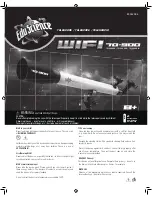
11
THE PLANETS
In addition to the Moon, your telescope is capable of observing the 5 brightest planets. Since planets change their positions
against the background stars, you will need to consult sources on the web or use a planetarium app on a smart device to
help you locate where these are. Here are some things to look for:
•
Mercury and Venus-
Just like the Moon, the two inner planets will go through phases ranging from thin crescents to
gibbous phases.
•
Mars-
When it is near opposition (the point in its orbit where it is closest to Earth) you should be able to discern the polar
cap and possibly some larger surface features that appear as dark markings on the surface.
•
Jupiter-
Look for the darker methane cloud bands that circle the planet just above and below the equator. If the Great Red
Spot is facing the Earth, you may be able to catch a glimpse of it. You will also see the four brightest moons of Jupiter – Io,
Europa, Ganymede, and Callisto. These moons are fun to watch because they can move appreciably over just a couple
of hours. Occasionally they will travel behind Jupiter or into its shadow and disappear for periods of time. They can also
cross the face of Jupiter and you may even see a shadow of the moon crossing with it. There are some useful apps for
smart devise that will help you predict when the Great Red Spot can be seen as well as when any interesting events are
going to occur with Jupiter’s moons.
•
Saturn-
The rings! Saturn is arguably one of the most beautiful objects to look at in a telescope. If seeing conditions are
stable enough, you may even catch the shadow of the rings on the planet and the shadow of the planet on the rings. You
should be able to see Titan, the brightest moon of Saturn.
DEEP-SKY OBJECTS
Deep-sky objects are all of those celestial objects that are outside of our solar system. They include star clusters, planetary
nebulae, diffuse nebulae, double stars and other galaxies outside our own Milky Way. Objects such as nebulae and galaxies
can be quite large, but they are also very faint. In order to get the best view, you will need to make sure you are in the darkest
skies possible. The farther you are away from city lights, the better you will see these objects in the eyepiece. In photographs
of nebulae and galaxies, you will see vivid reds and blues. These colors are not visible when you look through the eyepiece.
The colorful images were very long exposure images taken over 15 – 60 minutes or more, where your eye only records data
on an instant by instant basis. Digital sensors are much more sensitive to reds and blues than the human eye is which is
most sensitive in the green part of the spectrum. Still, you will be able to see the soft glow of the Andromeda galaxy and the
expanse of the Orion Nebula.
SKY CONDITIONS
Sky conditions can significantly affect the performance of your telescope in three ways.
•
Steadiness of the air-
On windy days, images of the Moon and planets will appear to wave or jump around in the
eyepiece; as if you are looking at them through moving water. Nights where winds are calm will offer the best higher
magnification views of the planets and the Moon. The best way to judge the stability of the atmosphere is to look at bright
stars with the naked eye. If they are “twinkling” or rapidly changing colors, the air is unstable and you are better off using
lower powers and looking for deep sky objects. If the stars are sharp and not twinkling, the air is stable and should offer
great high magnification planetary views.
•
Transparency-
How clear is the air you are looking through? If there is a high amount of humidity in the air, the faint light
from galaxies and nebulae can be scattered and diffused before reaching your telescope, causing a loss of brightness
in your image. Debris in the air from local forest fires or even distant volcanic eruptions can contribute to large loss of
brightness. Sometimes this humidity or debris can help stabilize the air, making for good planetary and lunar images, but
the loss of light would make it difficult to see fainter deep-sky objects.
•
Sky Brightness-
The amount of ambient light in the atmosphere can also effect deep-sky observing. How dark the sky is
can depend on your local surroundings. In the middle of a city, sky-glow caused by city lights being reflected back to earth
from the sky can overpower the faint light from distant galaxies. Getting away from the bright lights of a major city can
make the difference between seeing a faint deep-sky object and missing it altogether. Planets and the moon are plenty
bright enough on their own so the effect on observing them is minimal.
Summary of Contents for 21182
Page 1: ... 21182 INSTRUCTION MANUAL ...
























